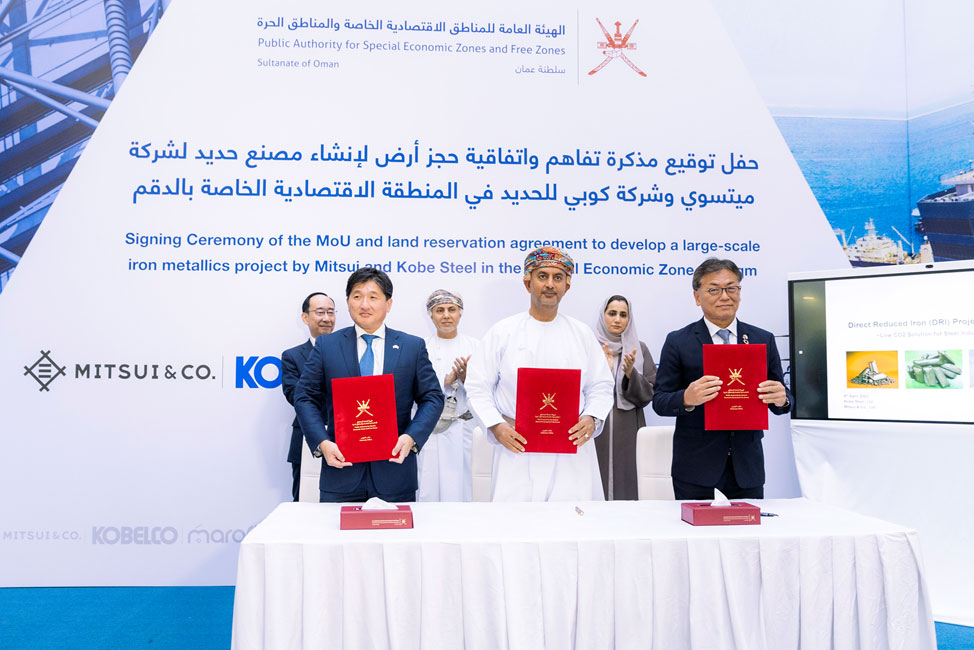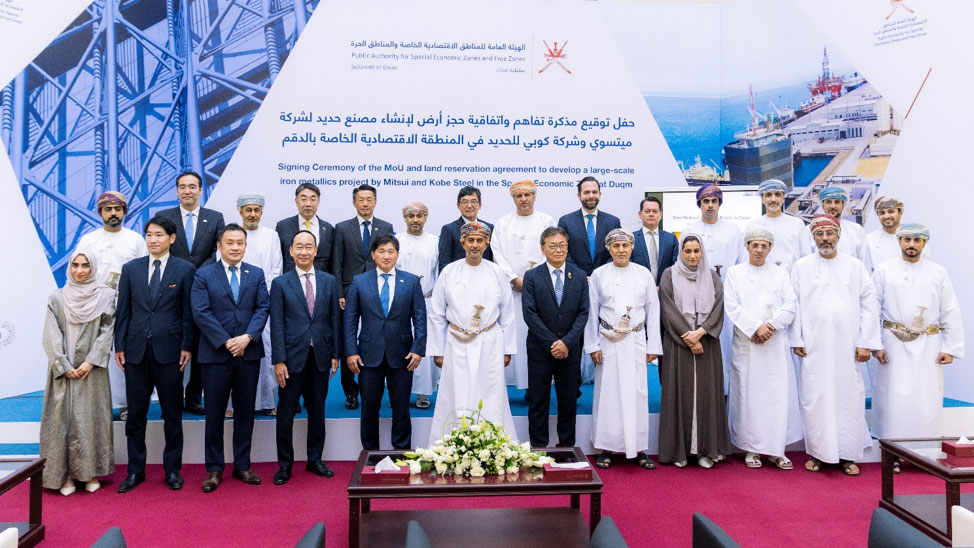April 10, 2023
Kobe Steel, Ltd.
Kobe Steel, Ltd. and Mitsui & Co., Ltd. have signed a memorandum of understanding (MoU) on comprehensive cooperation for the Low-CO₂ Iron Metallics Project to commercialize the manufacture and sale of direct reduced iron (DRI)*1 produced through Kobe Steel’s MIDREX® Process*2 with the Public Authority for Special Economic Zones and Free Zones (OPAZ) and also have concluded a Land Reservation Agreement with Port of Duqm Company S.A.O.C. (PODC).
OPAZ is an Omani authority that oversees all the special economic zones and free zones in Oman, and PODC is an Omani entity that operates the Port of Duqm. Kobe Steel and Mitsui have also been in discussion with the Sultanate of Oman’s Ministry of Energy and Minerals on detailed condition for natural gas supply. Having confirmed the site and cooperative framework in Special Economic Zone at Duqm in Oman, Kobe Steel and Mitsui will move the feasibility study forward.
Oman is a country rich in natural gas, which is used in the Midrex® Process, as well as an ideal location for the Low-CO₂ Iron Metallics Project as the country promotes renewable energies and green hydrogen based on Oman Vision 2040*3. While natural gas is used as a reducing agent in the Project for the time being, replacement of natural gas by hydrogen and combination with carbon capture, utilization, and storage (CCUS) will be considered to further reduce CO₂ emissions.
The Project aims to produce 5 million tons of DRI with a future expansion plan under study.
The steel industry is working on reduction of CO₂ emissions to address climate change. Kobe Steel Group (also known as Kobelco Group) set the vision for 2050 in May 2021, aiming to achieve carbon neutrality in its production process and contribute to over 100 million tons of CO₂ emission reduction through its technologies, products, and services. The Group already verified the technology*4 that can reduce a significant amount of CO₂ emissions from blast furnace operations leveraging its collective strength of diverse businesses. Kobe Steel is the first Japanese company that has commercialized low CO₂ blast furnace steel products with the launch of Kobenable Steel*5. In the field of DRI, the Group has commercialized unique technologies such as MIDREX Flex™ that can be transitioned to 100% hydrogen and MIDREX H2™ using 100% hydrogen as a reducing agent, in addition to MIDREX NG™, which uses natural gas.
The Kobelco Group is working proactively toward decarbonization of the steel industry and carbon neutrality with combination of steelmaking experience, key technologies such as MIDREX® Process, and the collective strength of Mitsui operating global business in the natural resources and energy fields.
*1: Direct reduced iron or DRI is feed stock for steelmaking. DRI can be used in electric arc furnaces, blast furnaces, and basic oxygen furnace melt shops. Hot briquetted iron (HBI) is DRI in a compacted, briquetted form, which is suitable for long-distance transportation.
*2: MIDREX® Process converts iron oxide into direct reduced iron (DRI) inside the shaft furnace using hydrogen-rich gas coming from natural gas or hydrogen as a reducing agent. Over 90 MIDREX® Plants (MIDREX NG™ Plants) are in operation across the world. Using both carbon and hydrogen molecules in the natural gas for reduction allows an immediate reduction of CO₂ emission by maximum 40% compared to the traditional blast furnace which uses primarily coal. Kobe Steel owns MIDREX NG™ as well as MIDREX Flex™ that can be transitioned to 100% hydrogen and MIDREX H2™ using 100% hydrogen as a reducing agent. With use of 100% hydrogen as a reducing agent, MIDREX Flex™ and MIDREX H2™ can reduce CO₂ emissions to zero.
*3: The Oman government aims at economic diversification and employment promotion through implementation of Oman Vision 2040 and other policies. The government aims to make the country a regional hub by developing a new industry other than oil and gas. Renewable energy and green hydrogen projects are characterized as a pillar of the vision.
*4: This technology achieves a significant reduction of CO₂ emissions from the blast furnace by charging into the blast furnace a large amount of HBI manufactured via the MIDREX® Process, a direct reduced ironmaking process, accounting for about 80% of the world’s natural gas-based direct reduced iron (DRI) production (60% of the world’s overall DRI). It can reduce CO₂ emissions in the blast furnace ironmaking process by 20–40%.
*5: Kobenable Steel, developed by Kobelco Group’s original CO₂ reduction solution for blast furnace ironmaking, allows the supply of low-CO₂ steel products that maintain the same level of high quality as conventional products.

Signing Ceremony in Muscat, the Sultanate of Oman on April 9, 2023
From left to right, front to back
Mr. Tetsuya Fukuda, Executive Managing Officer, Chief Operating Officer of Mineral & Metal Resources Business Unit
H.E. Dr. Ali bin Masoud Al Sunaidy, Chairman, OPAZ
Mr. Masahiro Motoyuki, Executive Officer, Head of Engineering Business, Kobe Steel, Ltd.
H.E. Jota Yamamoto, Ambassador Extraordinary and Plenipotentiary to Oman
H.E. Eng. Ahmed bin Hassan Al Dheeb, Deputy Chairman, OPAZ
H.E. Ibtisam Ahmed Said al Farooji, Board Member for OPAZ, Undersecretary for Ministry of Commerce, Industry and Investment Promotion

(Note) The information on this web site is presented "as is." Product availability, organization, and other content may differ from the time the information was originally posted. Changes may take place without notice.